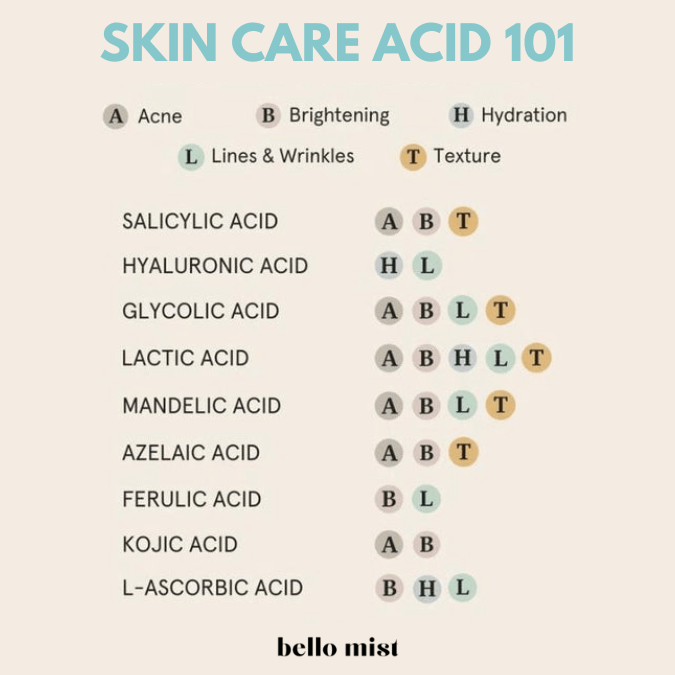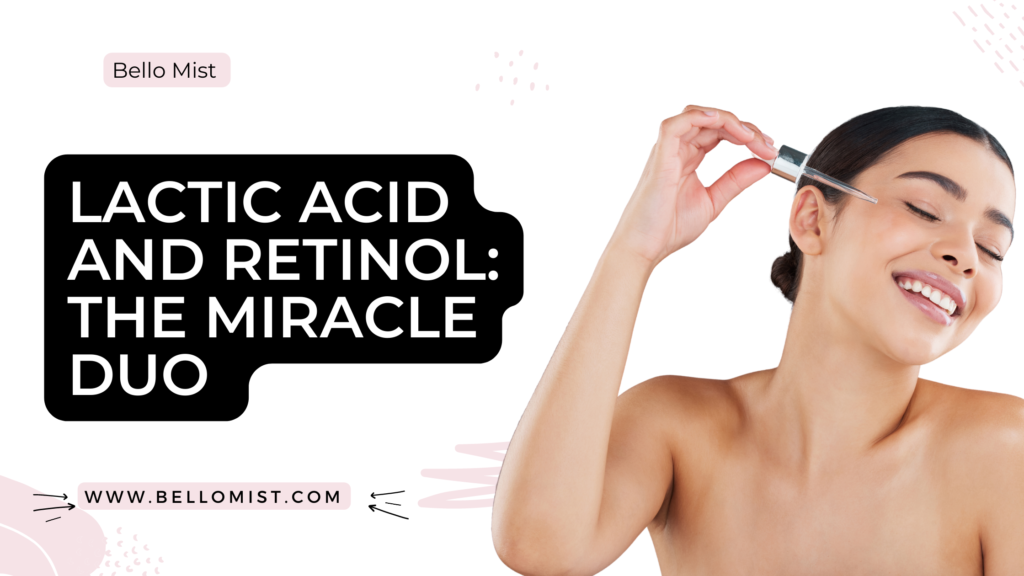Do you want to eliminate your dull, dry, or wrinkled skin? Then, two unique products should be your go-to: lactic acid and retinol. These two are now becoming popular in skincare as they are said to bring back a glowing radiance to your complexion and make it look more youthful.
Lactic acid is alpha hydroxy acid (AHA) that exfoliates the skin, while retinol is a form of vitamin A that boosts cell turnover. Integrating lactic acid into your skincare regimen can amplify the effects of retinoids, giving you smoother skin and eliminating any blemishes.
In this article, we will be looking into how to safely use lactic acid and retinol and some tips on using these products for optimal outcomes.
Main skincare benefits of lactic acid
Lactic acid is an effective AHA that brings natural exfoliation and deep moisture to sensitive facial skin. It is derived from cultured milk, which is why in old times, people enjoyed milk baths for their skincare.
What’s more, lactic acid assists your skin’s natural self-care mechanisms; therefore, lactic acid products are compatible with what your skin does to keep you healthy.
Unlike other AHAs, lactic acid provides deep hydration to dry skin and helps it retain moisture for longer. Due to its hydrating properties, this acid is becoming famous for its brightening and smoothing effects.
Lactic acid regularly removes dead skin cells and encourages the growth of new cells, resulting in a brighter complexion. Exfoliating with lactic acid on the top layer of the skin helps blur the appearance of fine lines and shallow wrinkles.
Plus, it can diminish the visibility of blemishes and dark spots, allowing you to achieve a youthful glow.

Main skincare benefits of retinol
Retinol is a gentler variation of retinoids that helps to exfoliate your skin and keep it looking vibrant and youthful. It is a concentrated form of Vitamin A and is becoming a vital addition to the newest anti-aging skincare solutions.
Studies have demonstrated its effectiveness in tackling acne, photoaging, hyperpigmentation, and even mild acne scars. Furthermore, retinol helps to regulate your skin’s hydration levels, although this occurs after the initial irritation.
Given the potency of retinol, it is essential to use this ingredient correctly. It is not as mild as lactic acid, so many skin care professionals recommend building up to a nightly application.

Difference between lactic acid and retinol
Lactic acid and retinol are two potent skincare ingredients with several noteworthy differences.
Retinol, a vitamin A derivative, is ubiquitous in anti-aging cosmetics and is renowned for its capacity to reduce wrinkles and enhance skin texture and tone.
On the other hand, lactic acid works as a natural exfoliator to break down the connections between dead skin cells. Additionally, it has moisturizing properties to improve the look of dry skin.
Let’s look at the main points of differentiation between lactic acid and retinol.
Retinol is a Better Wrinkle Reducer
Research has demonstrated that retinol is superior to lactic acid in diminishing wrinkles. A study revealed that retinol had caused a 36% reduction in wrinkles after twelve weeks of use, whereas lactic acid only achieved a 10% decrease.
Retinol is More Irritating
Retinol is more likely to cause inflammation than lactic acid due to its heightened exfoliating properties. If you’re new to using it, you may experience redness, dryness, and even peeling. Lactic acid might be a better option if your skin is particularly delicate.
Lactic Acid is More Hydrating
Lactic acid has a unique ability to draw in moisture to the skin, so it’s a great way to combat dry and flaky skin. In contrast, retinol can lead to dryness and irritation if it’s not applied correctly – and it doesn’t have any hydrating qualities like lactic acid.

How does retinol complement lactic acid?
Retinol speeds up cell renewal, giving a powerful boost when used with lactic acid. It also helps the skin to create more collagen and maintain the already existing collagen, making it appear fuller and brighter.
This powerful ingredient can help to reduce the observable signs of aging, like fine lines, wrinkles, pores, and discoloration. Retinol can even help to clear up existing blemishes by getting into the pores and eliminating the bacteria causing them.
Retinol is a must-have for those who suffer from frequent blemishes to keep their complexion looking young and vibrant.

Can you use lactic acid and retinol together?
The answer is yes; retinol and lactic acid are a magnificent pair. You may have encountered information that states that the combination of lactic acid and retinol can be complex on your skin and that you should only use lactic acid and retinol on alternate nights due to their strength.
However, that isn’t always the case. You can use lactic acid and retinol together when the percentages are correct.
After all, lactic acid and retinol are solid chemical exfoliants. If you use them in their fullest, most concentrated forms, it’s best to be cautious when combining them.
Employing more than one exfoliant in your regimen has a high chance of causing irritation and redness, mainly if your skin is sensitive.
Research has revealed remarkable transformations can occur when combined with lactic acid and retinol. One of the most current innovations in the skincare world is time-released retinol.
Formulas that gradually release retinol can boost the effects of lactic acid and create a compelling product that produces remarkable outcomes.

Can you use BHA and retinol together?
If your skin is sensitive, oily, or prone to congestion, Beta Hydroxy Acids (BHAs) can assist in clearing deep pores, reducing inflammation, and preventing acne or breakouts.
While mixing acids and retinol is not always advisable, you can still fit both into your skincare regime. You apply them in the proper order and timing to minimize any potential aggravation and maximize results.
It would be best if you use retinol in the evening as it can be broken down by light and make your skin more exposed to the sun’s rays.
On the other hand, Beta Hydroxy Acid should be implemented in the morning as it effectively eliminates the dead skin cells caused by the retinol application overnight.
Can you use AHA and retinol together?
AHAs are great for hydrating and sloughing away dead skin cells to make your complexion look brighter. Alpha-hydroxy acids are effective in treating normal, dry, or mature skin.
It’s important to remember that the same principles for using BHA and retinol concurrently also apply to AHA and retinol. Some people even use all three together.
Be sure to space out the product applications throughout the day. This will give your skin time to absorb each product and allow it the chance to renew itself.

How to use lactic acid and retinol in your skincare routine?
If you’re planning to include lactic acid and retinol in your skincare regimen, there are certain things you need to bear in mind. To start, incorporate one product at a time and observe how your skin adjusts. Once it has, add in the other product.
Though it’s possible to layer the two, it may be better to use them separately and alternate nights. For example, you could use lactic acid one night and retinol the next.
If you still decide to use lactic acid and retinol together, look for any signs of inflammation or dryness. Remember that using both exfoliants simultaneously may lead to over-exfoliation and a weakened skin barrier.
Don’t forget to apply sunscreen during the daytime when using these products, as lactic acid and retinol can cause your skin to become more sensitive to the sun.
It takes time for your skin to adjust to new ingredients, so don’t worry if you don’t see any significant changes immediately. After giving it a few weeks, you’ll start to notice some positive results of using lactic acid and retinol, but it’ll take up to three months to see the amazing transformation.
Hang in there, and you’ll be amazed by the youthful look your skin can achieve from lactic acid and retinol.

Potential side effects of using lactic acid with retinol
Lactic acid may be considered a gentle ingredient, but when combined with retinol, it can lead to drying out and irritation of the skin. This is because retinoids rapidly send young, immature skin cells to the surface, which lactic acid sheds.
These cells are not as effective at keeping moisture in, leaving the skin dry, dehydrated, and very sensitive to the environment and potential infections. It can cause redness, itching, and discomfort when exposed to simple everyday items like water.
In the short term, there may be some peeling, irritation, and redness when using retinol and lactic acid. But long-term, retinol and lactic acid can lead to extreme sensitivity and even conditions like rosacea or irritant dermatitis.
We suggest contacting a dermatologist immediately if you face any adverse effects from using lactic acid and retinol.

Wrapping Up
Two excellent chemical components, lactic acid and retinol, are revolutionizing anti-aging skincare. These two ingredients can restore skin brightness, hydration, and clarity and diminish wrinkles and lines.
Although combining two chemical ingredients always requires caution, in this case, combining lactic acid and retinol can successfully combat aging skin.
Thanks to time-release technology, you can now find these two ingredients in one product. If you want the best results, start slowly and give it time. Remember to apply sunscreen every single day.
Read More
How To Use Salicylic Acid And Retinol Together For Best Results
